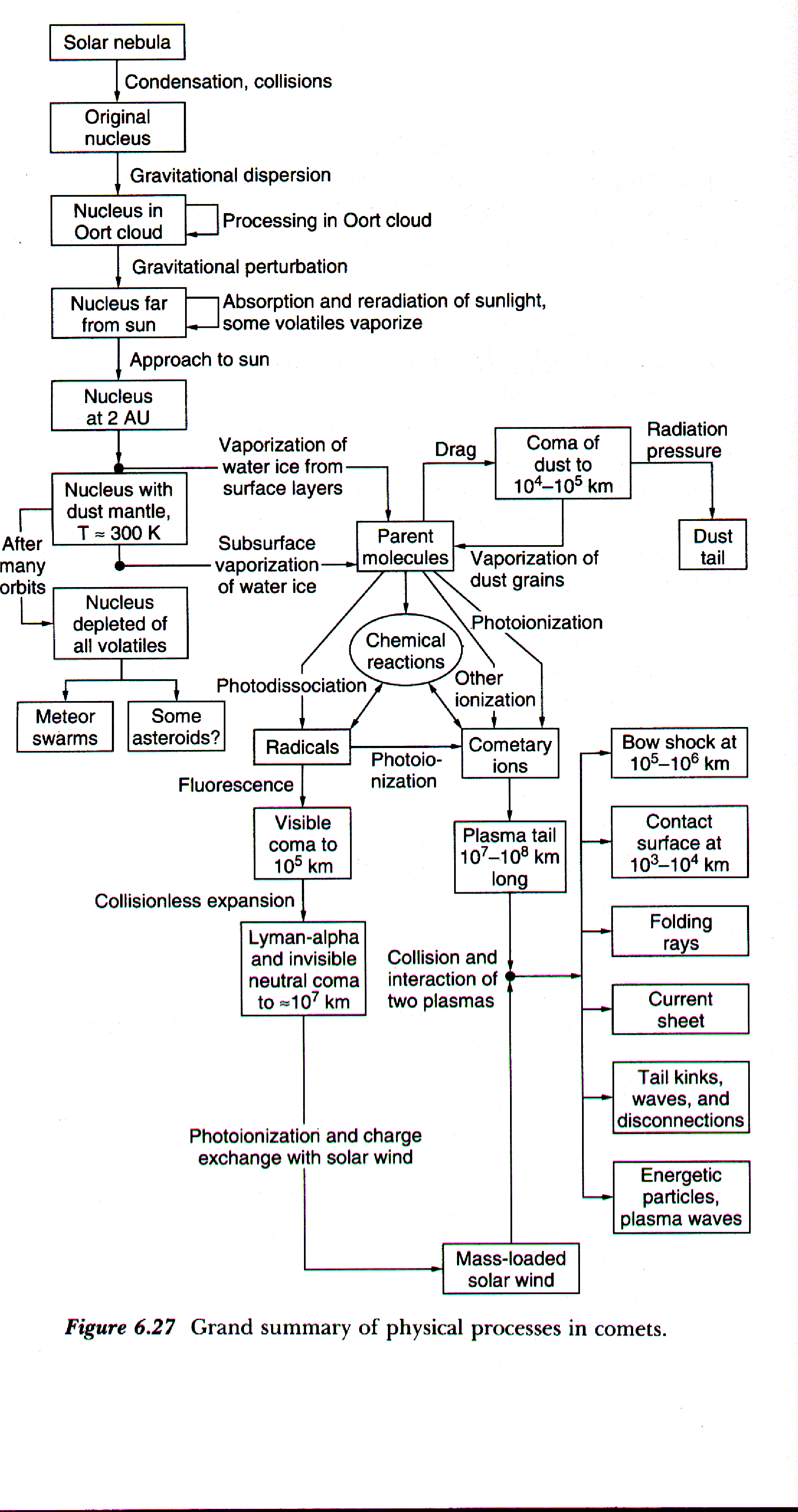What
is a comet? A “dirty snowball” Whipple would say. Comets
are not abnormal astrological objects that flare up in the sky. They
all have about the same chemical compound were originated in either one
of two places and orbit along the ecliptic. Although the most beautiful
comets are ones whose perihelion (point where an orbiting object is closest
to the Sun) directly crosses the Earth’s orbit. A few of these spectacular
comets are Halley’s, Hale-Bopp, Hyakutake, etc .  Comet Hyakutake
Comet Hyakutake Hale-Bopp
Hale-Bopp
Courtesy of Tsukasa Noda at http://www.nnettown.or.jp/~tsukasan/e-index.html
There are 92
atoms that occur in nature, and of those the most abundant are hydrogen
(H), helium (He), oxygen (O), carbon (C), and nitrogen (N) which profuse
the nucleus, or head, of every comet. Most of the icy matter
is composed of pieces rich in hydrogen (usually in the form of methane,
ammonia, carbon dioxide, and water) mixed with minute particles of dust
and rock. The ice forms a crystal lattice, which works as a cage.
Molecules get trapped inside the pockets, densely packing the nucleus.
Two things happen when the comet passes close to the sun. First,
it starts emitting a beautiful tail and second, a hydrogen casing is formed.
The icy
tail, or ion tail, that each comet produces can range from grandly exquisite
to dimunitively plain. As the icy cosmic chunk nears the sun, different
atomic particles excite at varying temperatures. When one substance’s
temperature is reached, the atoms start moving so violently that they break
of vaporizing instantly skipping the liquid stage. Contrary to the Earth
space has no atmosphere, once the atoms vaporize they are lost forever.
Comets tend to lose on average 1 meter of material each time it travels
along the perihelion.
There
are different distances that each atomic substance vaporizes. During
the comet’s orbit towards the sun, the temperature around Neptune’s distance
is warm enough to melt the topmost layers of methane ice. By Saturn,
ammonia becomes restless, between Saturn and Jupiter it is carbon dioxide.
Just before the comet reaches Mars water finally is warmed enough to become
excited, along with the other ices. There is noticeably more
water within the ice than any other substance. This could be from
the loss of other volatile substances early on and that the water does
not melt until the inner planetary orbit. Feodor
A. Bredichin declared three different types of comet tails. Type
I consists of tails that are nearly strait, they appear to curve ever so
slightly backwards. These are the most spectacular and complex and
their form tends to change rapidly from moment to moment. The lightest
atoms compose these comets. Type III comets have curved stubby tails.
They contain heavier atoms such as Iron (Fe). Type II comets are
a combination of Type I and Type III comets


Parts of a comet (Chapman, p. 4)
Types of comet tails (Yeomans, p. 232)
As the
ice melts, a different tail made up of dust and other refractory materials
form a tail in the opposite direction of travel. Dust particle jets
that average around 15 km in diameter are active only when exposed to the
sun. When the rotation of the comet brings the jets into darkness,
they turn off. Another side effect of the ice melting is the hydrogen
envelope that surrounds the nucleus. As water evaporates, it absorbs
ultraviolet photons from the sun breaking the hydrogen apart. This
in turn creates an envelope when the hydrogen is grounded.
But why
are there even comets in existence? There are two reservoirs within
our Solar System that create our cosmic visitors: the Kuiper Belt and the
Oort Cloud. Just beyond Neptune’s orbit lies the Kuiper Belt.
Here comets form in the extra planetary debris that was left over.
The gravitational force of the planets, especially Neptune and Uranus,
pull the newly formed comets into an orbit around the sun. This creates
short-term orbits that are predictable since their orbits repeat no longer
than every 200 years.
The majority
of comets are believed to come from the Oort Cloud, which was first discovered
by Jan Oort in 1950. This interstellar cloud of debris is believed
to hold an estimated 12 billion comets. Since it is spherically distributed
around our Solar System, each comet has a long-term period of anywhere
from 1 to 30 million years. Every once in awhile a long-term comet
becomes short-term due to a planet’s gravitational pull, most often Jupiter’s.
With each
trip around the Sun, each comet exudes its dust, leaving it lying in space.
When the dust lies in the line of Earth’s orbit, it creates meteor showers.
There is an infinite supply of comets in space; man will always be able
to observe them as long as the sky is clear.
(Freedman, p. 402)


(Chapman, p. 160)


 Comet Hyakutake
Comet Hyakutake Hale-Bopp
Hale-Bopp

